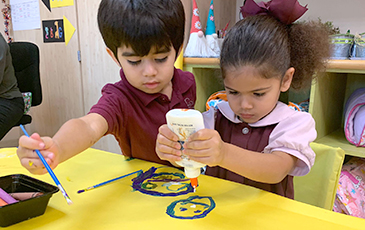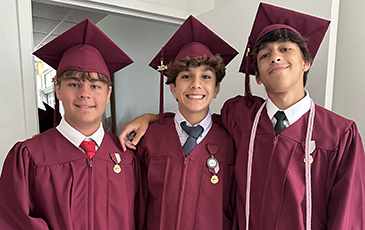In a K-8 educational setting, children can remain “young” and preserve the sacredness of childhood for the entire period of childhood. Students grow from being the youngest in the school to taking on leadership roles as the oldest, giving them an opportunity to serve as role models and thrive with a vibrant sense of community. The result is greater confidence, self-esteem and a sense of belonging, which translates into stronger academic performance at a developmentally appropriate pace.
In the first 14 years of life students need the stability of a nurturing environment in which they can develop and grow, take risks, allow themselves to be vulnerable, and accept challenges, within a space that offers them support they need to confidently engage in age-appropriate activities while feeling nurtured and loved. Based on child development theories, by age 14 children have developed basic human skills and have stepped over the threshold to the beginning phases of adulthood. Not only is there a significant evolution in the physical development of a child entering adolescence, but intellectually children begin to develop deeper abstract thinking, socially they begin to rely more heavily on a stable peer group for support, and emotionally, their temperament begins to stabilize. The American Educational Research Journal and numerous other research studies validate the benefits of a K-8 education and the distinct advantages for students academically, socially and emotionally. Furthermore, the participation in the Senior Mastery Program at CEA, which includes daily time dedicated to pursuing an area of passion, allows all students to find a sense of community alongside a peer group that shares their common interests in an environment of support. By the time CEA students reach the 8th grade, they have earned the right to have a voice in what high school they attend based on how they have evolved and developed and feel confident that they will approach the next stage with the competency to succeed.
Curriculum
Conchita Espinosa Academy provides children with a complete education, which extends beyond traditional schooling, in order to create well-rounded and balanced individuals. Through the integration of solid academic and arts curricula, students learn to think and develop the work ethic, time management skills, and sense of responsibility key to success and balance. A strong academic foundation ensures students have the tools and preparation to succeed. The arts and a growth mindset help students develop vital skills, such as the ability to communicate clearly, think critically, work collaboratively, develop discipline, and embrace change.
Throughout the school day, character education takes place, and students are engaged in an environment that fosters the development of self-discipline, respect for self and other, and empathy. In addition to the core academic subjects (math, science, reading, grammar, writing, and social studies), all students take D.R.E.A.M.S. classes (dance, religion, español, art, music, and sports). Students in third through eighth grade participate in the Mastery Program.

Early Childhood Education
K3, K4 & K5 (Pre-Primary)
Our early childhood program provides students with the opportunity to develop the natural curiosity and sense of wonder inherent in all children. We work to create experiences that enhance intellectual, emotional, social, and physical growth while honoring the unique time in life known as childhood. Students are…
Read More >
Lower School
Grades 1-4
Through a solid academic curriculum, lower school students at Conchita Espinosa Academy (CEA) acquire the necessary skills and knowledge allowing them to grow. Our curriculum encompasses more than the standard format of reading, language arts, math, social studies, and science.
Read More >
Upper School
Grades 5-8
Upper school is the culmination of the eleven-year process students experience at CEA. Our upper school is uniquely designed to meet the challenges of the early teen years. Students are provided the necessary continuity, structure, and security required for a successful transition from childhood to adolescence.
Read More >



